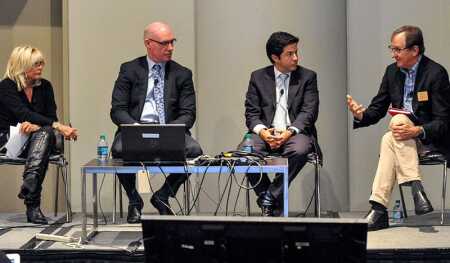
From left: Toni Alexander, president and creative director of InterCommunications Inc.; Patrick K. Fitzgerald, president and chief executive officer of Hualalai Resort; Carlos Hernandez-Garcia, chief executive officer, Pellas Development Group; and Harry H. Frampton III, managing partner of East West Partners-Western Division.
Resorts and vacation homes—always the last real estate sector to recover from an economic downturn—are seeing increased activity, but developers are looking toward the future. Everyone agrees that Dad’s favorite golf resort does not appeal to his children or grandchildren—but what does?
Toni Alexander, president and creative director of InterCommunications, moderated a ULI Fall Meeting session titled “Not the Last Resort,” featuring industry icons Patrick Fitzgerald, president and CEO of Hualalai Resort; Harry H. Frampton III, managing partner of East West Partners–Western Division; and Carlos Hernandez-Garcia, CEO of Costa Rica–based Pellas Development Group.
“Millennials are the largest single customer generation in history, spending over $200 billion annually,” Alexander noted. “But many cannot afford a first home, much less a second one. Can we please every generation in a single destination? What are developers doing to prepare for the future? Is agriculture the new golf?”
Fitzgerald pointed out that at his Hualalai Resort, he has not tinkered with the basic model, but has invested heavily in improvements, adding 51 suites to the property’s 243-room Four Seasons hotel, revamping the main restaurant to serve as an outdoor living room where guests gather daily to watch the sunset, and rebuilding a swimming pool that was damaged in the 2011 tsunami. In another restaurant, a disconnected bar was moved to the center of the space, providing possibly the best bar view in Hawaii. The investment already is paying off: this year, the resort owner will close over $150 million in residential sales for just 300 units.
But at the end of the day, Fitzgerald said, “it’s always about the experience.” He shared an anecdote: a waitress asked a seven-year-old girl if she had done everything she wanted to do on her trip to Hawaii. The girl replied that she wanted to learn how to dance the hula. Upon hearing that, the waitress immediately started teaching the girl to dance, bringing tears to her parents’ eyes. “I knew I had that family for next 20 years,” Fitzgerald said.
Hernandez-Garcia is taking a different approach to success in Costa Rica. Opening this month, Dreams Las Mareas in Guanacaste updates the all-inclusive model that has had a bit of a stigma in the United States.
“We have reinvented this concept, calling it ‘unlimited luxury,’” he said. “We have the amenities of a Ritz-Carlton but in a package format that’s more affordable and less intimidating for younger visitors and families. Each resort is unique, with beautiful architecture and special features like swim-out pools from suites.” While the pricing is all inclusive, residents can dine at five restaurants; there are no buffets.
The Costa Rican entrepreneur noted that this new resort is fully booked for December and January, with 100 weddings—so far—booked for 2015. He hopes not only to help redefine the all-inclusive concept, but also to anchor development of the surrounding land in the Santa Elena Preserve.
This new resort targets a wide range of customers, and Hernandez-Garcia said he is not attempting to focus on a narrow range for his company’s other products. In fact, he said, Latin Americans buy a large proportion of the company’s vacation homes.
“A lot of baby boomers are not interested in retiring in the middle of the jungle where it will take them ten hours to go see the grandkids,” he said. “Baby boomers who want to save money should try Cancun, which has evolved into the coolest place in Mexico with universities, cultural attractions, more direct flights from the U.S. than Mexico City.”
Frampton, whose company made its mark with mountain ski resorts, said he is changing course—moving from traditional isolated resorts to urban settings, including both large cities and college towns. He already has achieved success with second-home developments in New York City; Denver; Charleston, South Carolina; and Chapel Hill, North Carolina.
“We see more people who want to be around young people; the vitality rubs off,” he noted. “And one of the best things is that you don’t need to get in a car to include everything these resorts have to offer. In Denver, you have incredible restaurants, great retail, extensive bike trails, the most theaters of any city in the U.S. after New York, 50,000 college students, sports teams, museums, the potential for continuing education—and you don’t ever have to use a car.”
But even those isolated ski resorts are adapting to new realities, Frampton added. “People thought that the ski industry would collapse, but it is going strong,” he pointed out. Many resorts are cutting expensive lift fees and creating summer and year-round fun like zip-lining.
So what are the sector’s most cutting-edge concepts? One that fascinates Frampton is SoHo House, a hotel and club for 30- to 45-year-old professionals involved in creative industries; it has thousands of members. Similar concepts also are entering that arena; some are being dubbed “country clubs without the golf.”
And speaking of golf, why can’t that evolve too? “Why do you have to play 18 holes of golf or even nine? Why not six, or three?” asked Alexander. That and similar questions are bound to be on the minds of resort developers in years ahead, as everyone tries to figure out what the next big thing is—and how to get customers to pay for it.


